Poll: Foreign Policy
Mixed Opinions on Trump Foreign Policy
In the aftermath of the U.S. strikes in Iran, over 80 percent of Americans report hearing about the escalating conflict in the Middle East, including the U.S. bombing of Iran (81 percent). More than half (54 percent) say they have heard “a lot.”
Three quarters (74 percent) are concerned about the escalating conflict in the Middle East, including nearly half (46 percent) who find the U.S. bombing of Iran “very” concerning.
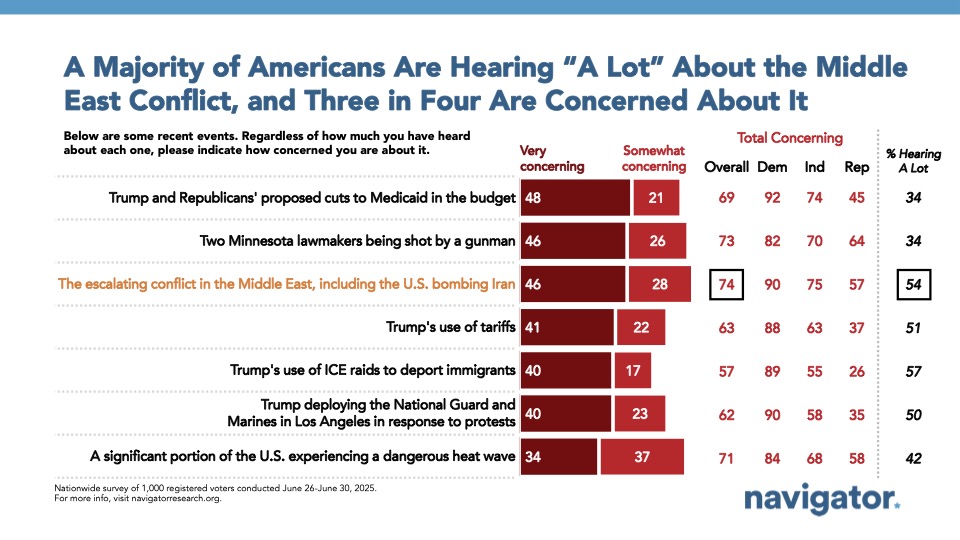
Half of Americans disapprove of Trump’s handling of the Middle East conflict and 47 percent disapprove of Trump’s foreign policy overall.
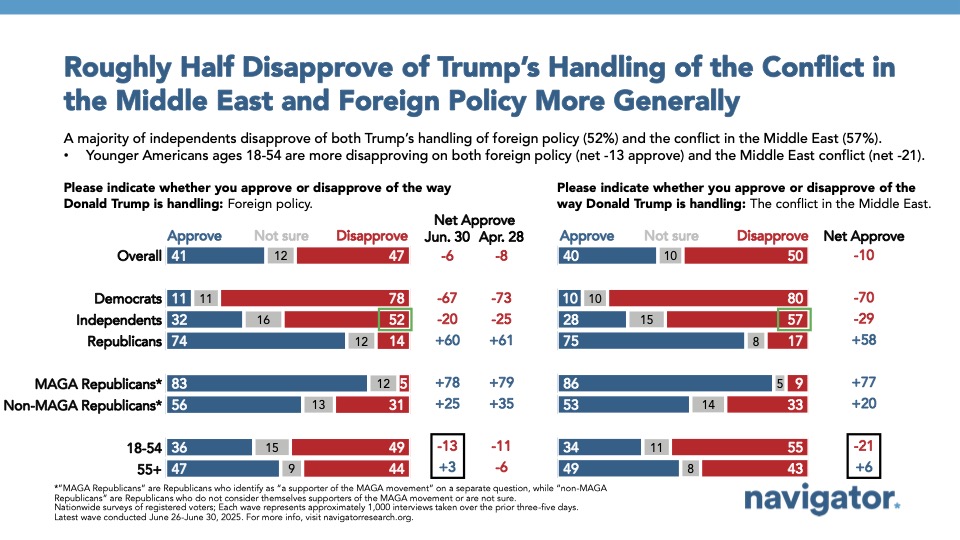
- 45 percent of independents say they don’t know how to assess Trump’s approach to foreign policy.
- When asked what positive and negative things they’ve recently seen, read, or heard about Donald Trump, respondents in both positive and negative cases most frequently mentioned “Iran” and “bomb.”
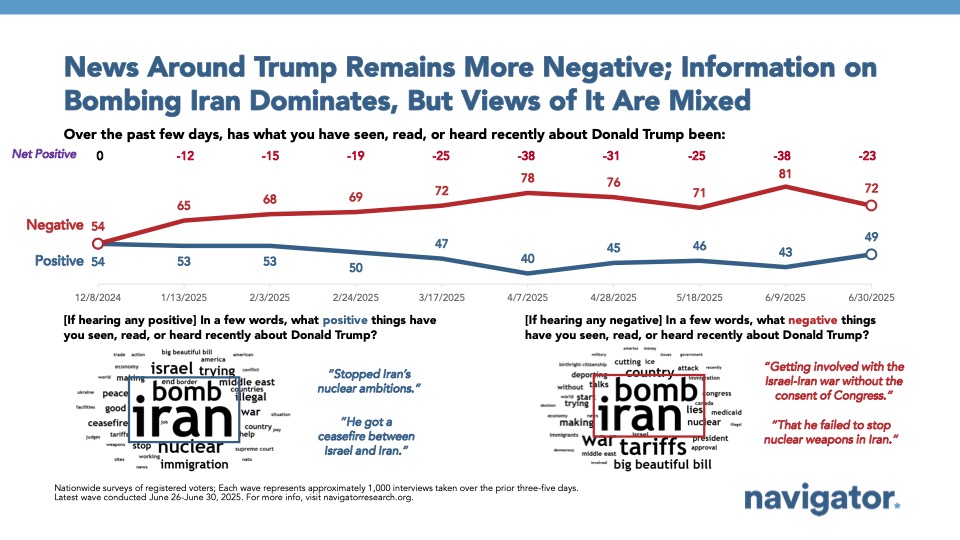
Congressional Republicans Continue to Hold an Edge on Safety and Security
Republicans hold an advantage over Democrats on key national security issues:
- Net +9 points on keeping Americans safe.
- Net +8 points on handling the conflict in the Middle East.
- Net +3 points on foreign policy overall.
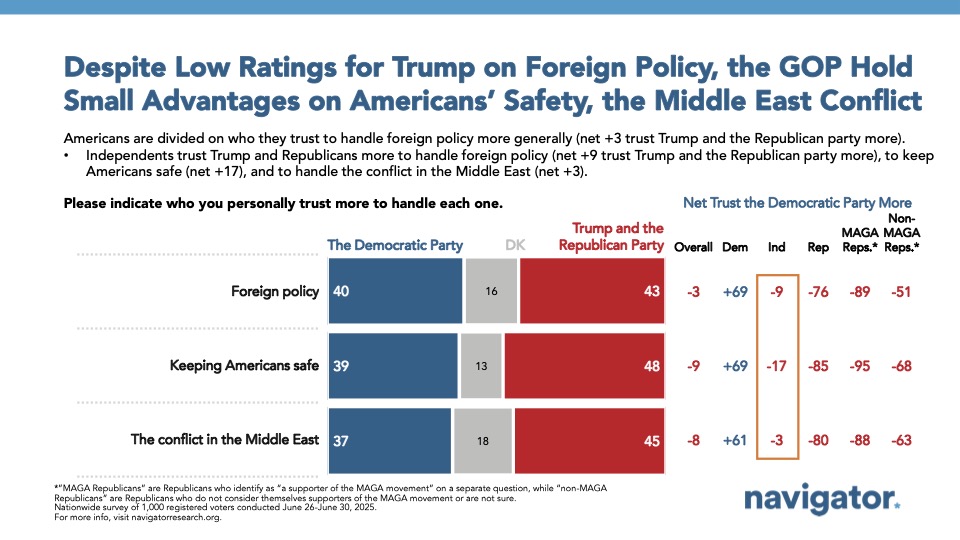
This reflects a consistent trend of increasing trust in Trump and Republicans when it comes to foreign affairs in Navigator’s ongoing tracking.
- Following Russia’s invasion of Ukraine in March 2022, Americans were evenly split on which party they trusted more on foreign policy, shifting to a 5 point advantage for Republicans in October 2023, widening to 14 points in January 2025, and narrowing to 3 points in light of recent events.
Divided Sentiment on Trump’s Iran Decision
Americans are split on whether Trump made the right decision in bombing Iran (45 percent believe it was the right decision, while 42 percent believe it to be the wrong decision).
The division is especially stark across partisanship and age:
- 70 percent of Democrats say it was the wrong decision.
- 84 percent of MAGA Republicans say it was the right decision, compared to 64 percent of non-MAGA Republicans.
- A majority of Americans over the age of 55 say it was the right decision (52 percent), while only 39 percent of those under the age of 35 say the same.
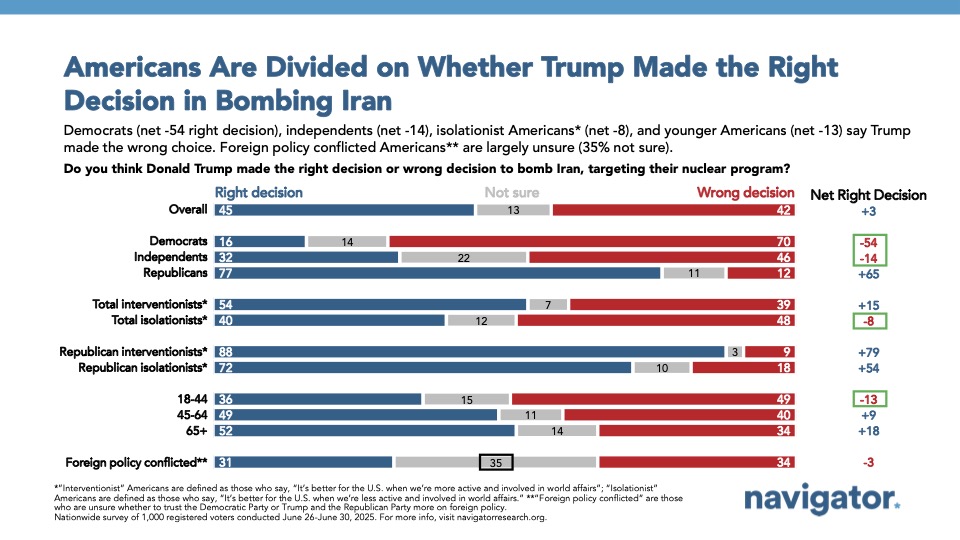
Among opponents of the strike, top concerns include:
- The risk of retaliation against the U.S. was the most cited across partisanship.
- Trump’s involvement in the Middle East is seen as a distraction from addressing the economy and inflation (one of the top concerns amongst Republicans).
- Increased chaos and violence globally and regional instability.
Congressional approval is a top concern only among Democrats. While 42 percent of Democrats cited the constitutional issue of lacking Congressional approval, only 18 percent of Republicans and 23 percent of independents listed it as a concern.
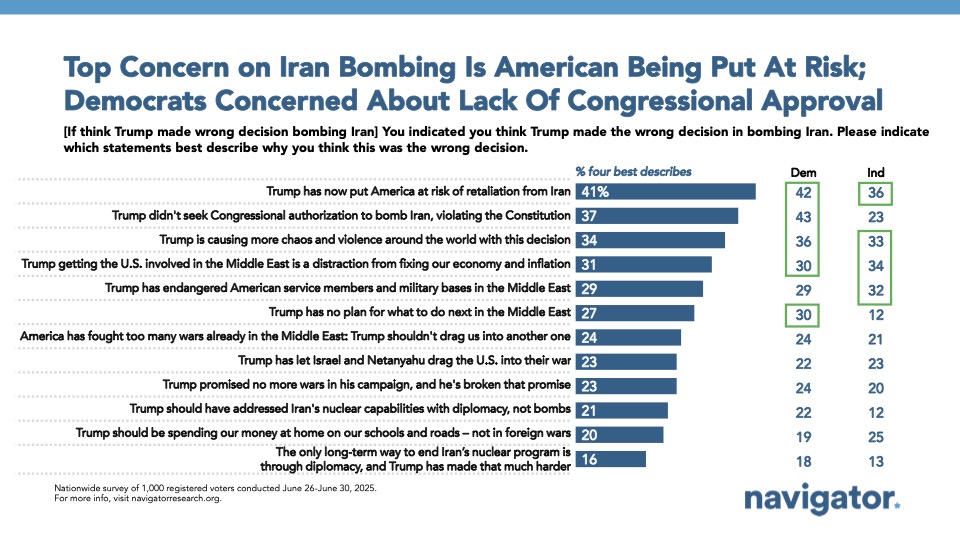
Support Fades for U.S. Military Involvement in Iran-Israel Conflict
Nearly half of Americans (48 percent) believe the U.S. should stop its military involvement in the Iran-Israel conflict. Just a third (35 percent) believe military involvement should continue.
- There are divisions within the Republican party on this issue. Overall, just 28 percent of Republicans support U.S. withdrawal from conflict in the Middle East. However, 61 percent of MAGA Republicans support continued military involvement compared to 46 percent of non-MAGA Republicans saying the U.S. should pull back.
- Two thirds (66 percent) of Democrats support withdrawal.
- Across all age groups, the majority say the U.S. should pull back from the conflict. Americans under the age of 35 reveal the greatest divide, 31 percent support continued military involvement, while 50 percent support pulling back from the conflict.
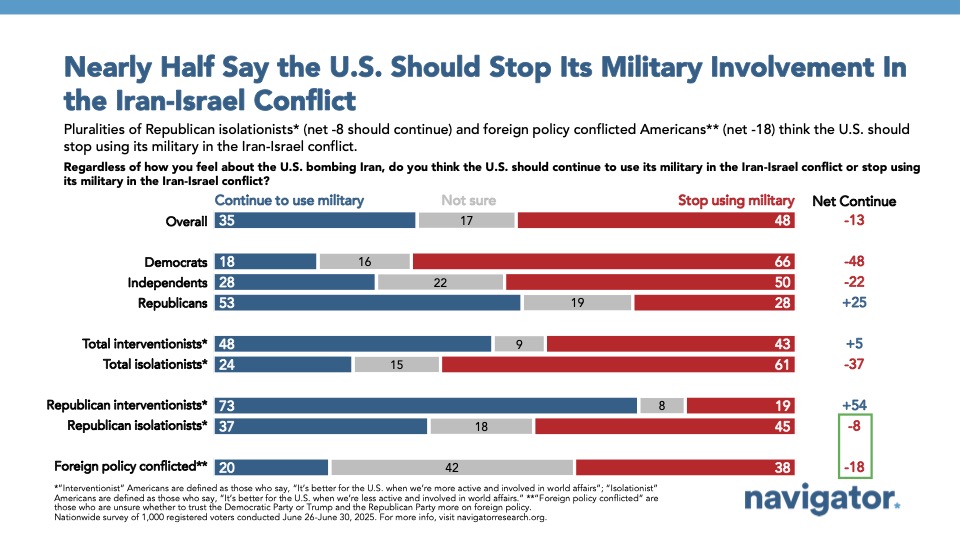
Isolationist vs. Interventionist Demographics
When asked whether it’s better for the U.S. to be more or less active and involved in world affairs, Americans are split: 48 percent favor a more active role, while 41 percent prefer a less active role. Support for intervention is nearly equal among partisans, with 48 percent of Democrats and 50 percent of Republicans in favor. Among independents, 45 percent say it is better for the U.S. when we’re less involved while 36 percent say the US should be more involved.
- Among Republicans, there are splits by education and age. Republican interventionists are more likely to be older and college educated.
- Men are more likely than women to hold interventionist views, with support for a more active U.S. role in world affairs sitting at 52 percent of men and 44 percent of women. Among both men and women, older Americans tend to be more interventionist: 60 percent of men over 55 and 50 percent of women over 55 support a more active U.S. role in world affairs.
- Americans without a college degree are evenly split with 44 percent holding more interventionist views and 44 percent holding more isolationist views. Contrastingly, 55 percent of Americans with a college degree tend to hold more interventionist views, compared to 36 percent with isolationist views.
- Gen Z is the most isolationist generation: 50 percent of Gen Z report it’s better for the U.S. to be less active and involved in world affairs, while only 45 percent of Gen X, 43 percent of Millennials, and 34 percent of Boomers say the same.
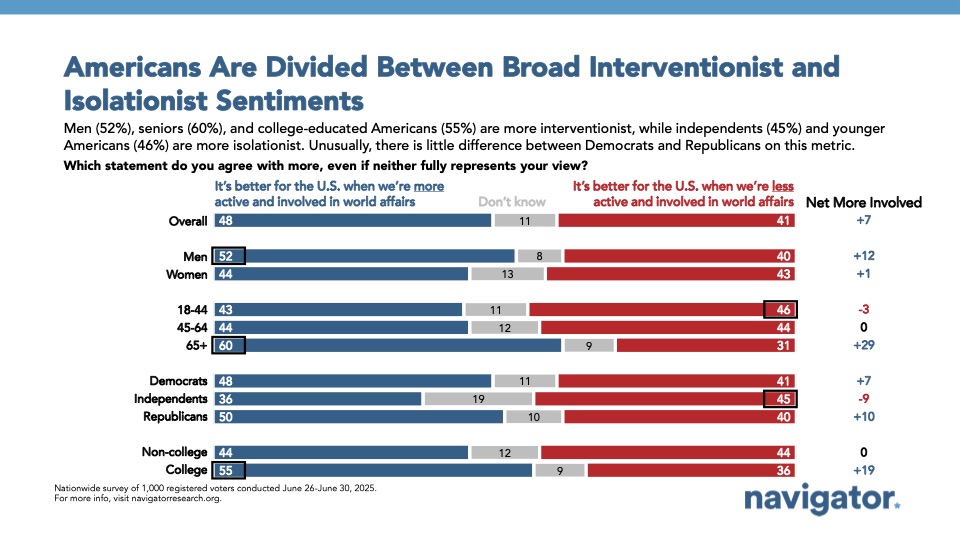
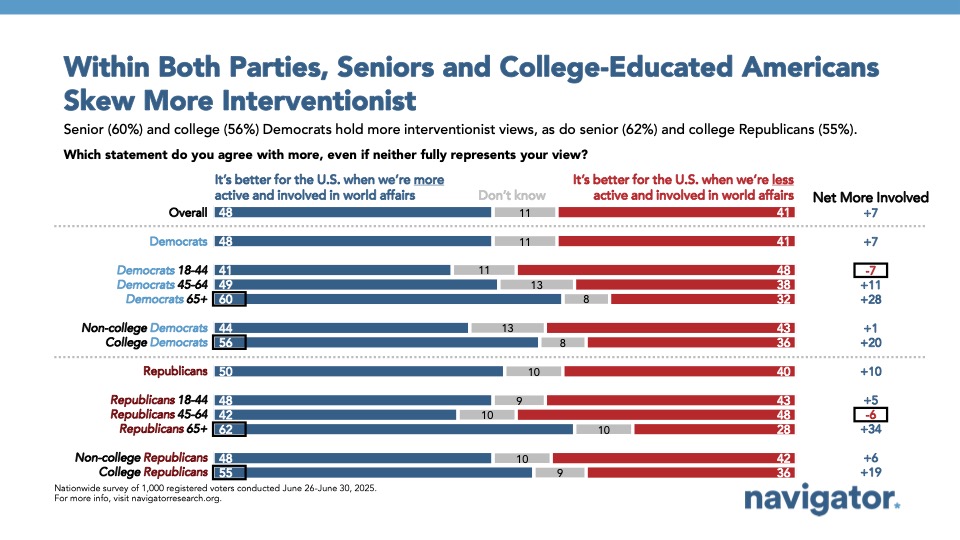
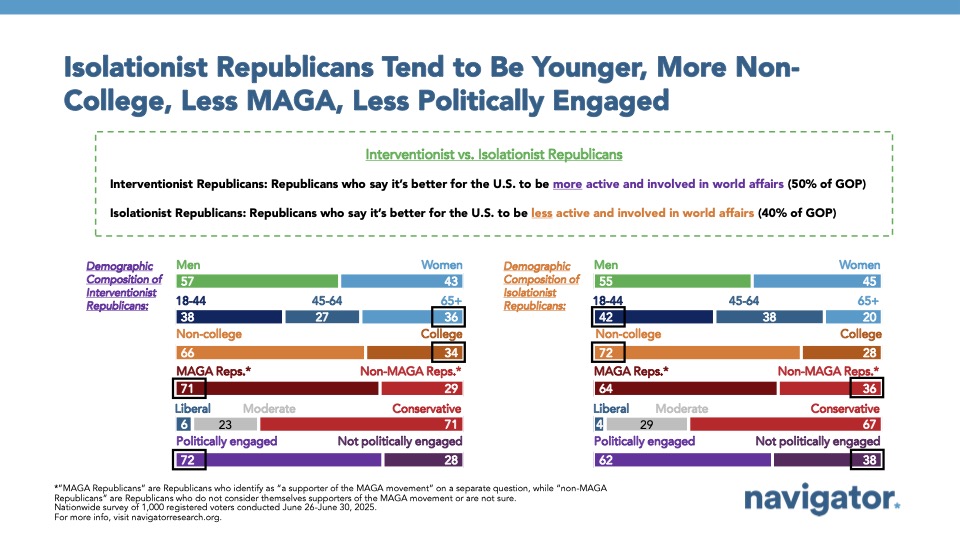
About The Study
Global Strategy Group conducted a public opinion survey among a sample of 1,000 registered voters from June 26-June 30, 2025. 100 additional interviews were conducted among Hispanic voters. 75 additional interviews were conducted among Asian American and Pacific Islander voters. 100 additional interviews were conducted among African American voters. 100 additional interviews were conducted among independent voters. The survey was conducted online, recruiting respondents from an opt-in online panel vendor. Respondents were verified against a voter file and special care was taken to ensure the demographic composition of our sample matched that of the national registered voter population across a variety of demographic variables. The margin of error for the full sample at the 95 percent level of confidence is +/- 3.1 percentage points. The margin of error for subgroups varies and is higher.




